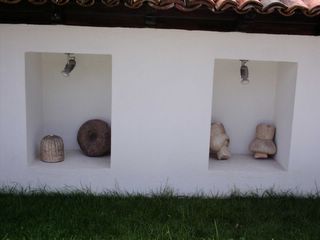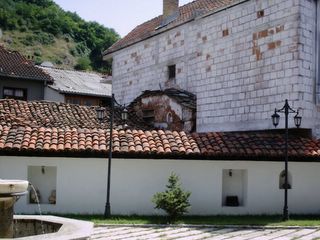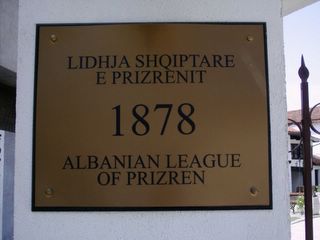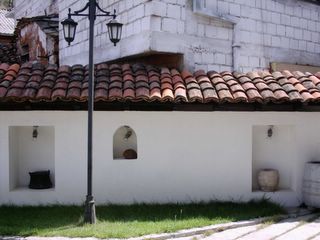I decided to officially archive this blog on the day my DPhil was confirmed. But I have waited for the electronic publication of my thesis, Interrogating Archaeological Ethics in Conflict Zones: Cultural Heritage Work in Cyprus, to announce the archiving. From now on, I will blog at Conflict Antiquities.
Saturday, August 27, 2011
Monday, March 19, 2007
 Prizren Namazgah 2b: this is a close-up of the public information board for Fatih Sultan Mehmed Namazgâhı or Kırık Camii (taken so I could read the English text afterwards).
Prizren Namazgah 2b: this is a close-up of the public information board for Fatih Sultan Mehmed Namazgâhı or Kırık Camii (taken so I could read the English text afterwards).It reads:
Namazgah stands for a mosque without a roof which is design[ed] for large groups to perform namaz together. This work was built on 21st of June 1455, [in] Fatih Sultan Mehmet's period. It is known that, in the past, near this mosque, which is called "Kırık Camii" by the public, there was a martyrdom. Digging and restoration activities of this work is done with the cooperation of Kosovo Turkish Task Force Battalion, Prizren Municipality, Prizren Institute for Protection of Ancient Works, Prizren Presidency of Islamic Unity, Turkish Republic Republic Religious Affairs Presidency, Turkish International Cooperation and Development Administration (TICA) and Turkish Gazi University Faculty of Science and Literature between 12th of October 2001 and 5th of April 2002.
Friday, January 12, 2007
Tuesday, December 13, 2005

Albanian League of Prizren Museum 3: the artefacts, here displayed on shelves set back into the exterior wall of the museum, include:
- far left, what looks like a sculpture of a woollen cap, but which, I imagine, is an architectural detail;
- centre left, what I think is a grindstone or door pivot, as it appears too large to be a loomweight;
- centre right, an architectural detail, the top of which is reminiscent of the "woollen cap" detail on the far left; and
- far right, a similar architectural detail, which is plainer and possibly unfinished.

Albanian League of Prizren Museum 2: this is the courtyard inside the museum complex, where some archaeological artefacts are displayed on shelves set back into the building's walls.
The artefacts are exposed outside, so they lack any protection from natural elements, like the weather and climate; however, they are accessible, so visitors can actually touch the past and feel it, which is a powerful way of engaging with it and helping to learn about it.

Albanian League of Prizren Museum 1: this is the plaque at the entrance to the Museum of the Albanian League of Prizren (Muzeumi i Lidhjes Shqiptare te Prizrenit). The League was established to protect Albanian communities from the Ottoman Empire's elites' abuses of power.
I can't remember where I got my interpretation from now; I don't have my reading with me. Vasilevs commented that:
Albanian league is the first organisation in Kosovo and Metohia (because the Kosovo is only the small part of that Srbian province)that is formed for aim of construction of "Greater Albania" (ethnic clean land of Albanians).International comunniti was help to Albanians to build that "dream".In its piece on Prizren Municipality, Human Rights Watch included a footnote on the League of Prizren that may serve as a middle ground:
The League of Prizren was founded in 1878, bringing together representatives of all Albanian inhabited regions to demand autonomy from the Ottomans. The establishment of the League was a landmark in the movement for Albanian self-determination. The building that was destroyed-where the League was organized-archived historic documents relating to the League's creation and activities.

Prizren building 69: this is a memorial to a priest.
The plaque reads:
ketu pushon: Veli Shah Baba, nga Horosani i cili vdiq ne vitin 1570. Ndertuesi i xhamise: Katip Sinani ne vitin 1577. Vorrin e Veli Shah Babes (si halim i madhe). Katip Sinani morri nen strehun e xhamise, ne anen e majte te hyrjes dhe vuri kuburen. Duke bere meremetinin ne vitin 1996 hoqen kuburen, per zgjerimin e koridorit dhe mafiles me nderime te larta xhemati i mahalles vendosi kete pllake te perjeteshme. Prizren 1997.This translates as: "here rests Father Veli Shah, from Horosani, who was born in Vitin in 1570. A mosque, Katip Sinani, was built in Vitin in 1577..." I just found this unfinished and unpublished; I'm not going to risk making any more errors of translation and have published it as it is.
Subscribe to:
Posts (Atom)













